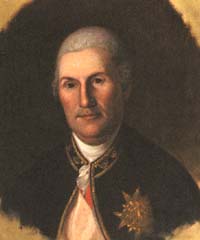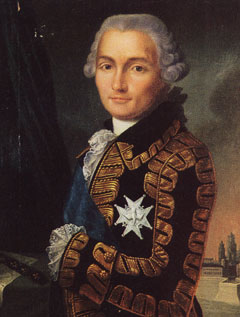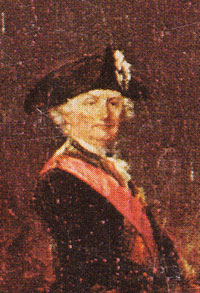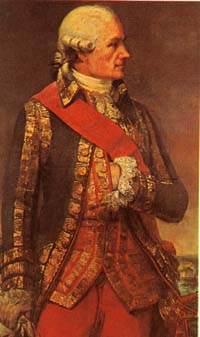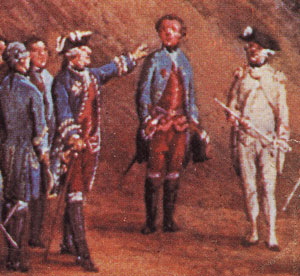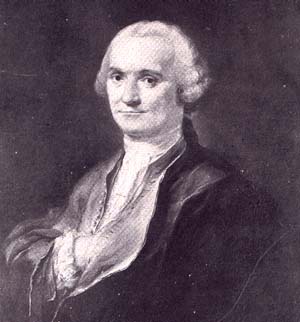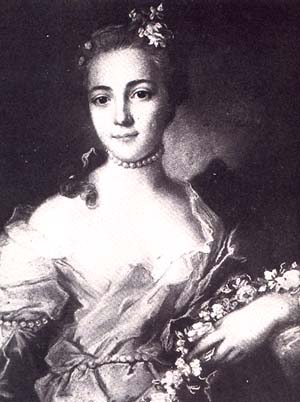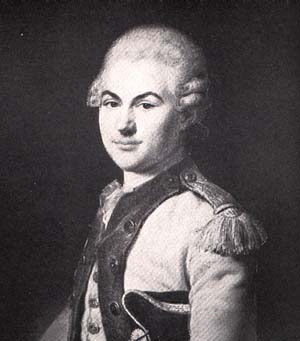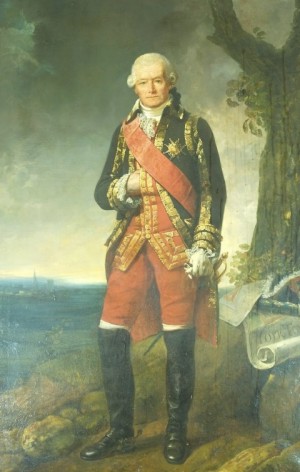|
The following images of Rochambeau and his family, but only a few are believed to have been executed during his lifetime.
|
|
|
|
Probably the most famous image of Rochambeau is the statue, by the French sculptor M. Fernand Hamar, that has many replicas at the following locations: one stands in one corner of Lafayette Square, across from the White House in Washington, DC; another in the Harbor of Newport, RI, (since 1934); one in King Park, New York City; and one in the square outside the Abbaye de la Trinité, in Vendôme. The latter was destroyed by occupying forces in World War II, but has been replaced.
|
|
|
|
|
|
Painting by Charles Wilson Peale, executed in 1782. Though there is every reason to believe that Peale could have painted the work from life, the facial features are puzzeling. Not only do they not reflect those of the various works executed by French artists, but they seem very similar to the features evidenced in Peale's paintings of George Washington. However, Peale keeps to his modest (and probably correct) rendition of the uniform for the period of the American Revolution. The gold color Maltese cross configured badge of the Ordre Royal et Militaire de Saint-Louis [Order of Saint Louis]. Also shown is the cordon rouge [red sash] signifying the highest rank in the order.
|
|
|
|
|
|
Rochambeau, painting by unknown artist, suspected of being at the visitors' center for the commune of Vendôme. A modern work, which shows a rather young face for the period suggested by the uniform shown. The comte wears the full dress uniform coat [blue with extensive gold lace] of a French general. The probably accompanying red waistcoat and breeches are not shown. Across his coat runs the cordon bleu of the Order of the Saint-Esprit, which he received in 1784. Also clearly sown is the silver breast badge [plaque] of that order.
|
|
|
|
|
|
Painting of Rochambeau which reportedly was given to Mus�e de Vend�me by Achille de Rochambeau [aka: Eug�ne Achille Lacroix de Vimeur marquis de Rochambeau (1836-1897, adopted on 10 May 1862). Like the preceding,work, it depicts the subject wearing the plaque of the Order of the Saint-Esprit. Two interesting additions are: Rochambeau's coat of arms is in the upper left corner, and the small golden "Eagle" of the Society of the Cincinnati established in France in 1784.
|
|
|
|
|
|
Rochambeau, painted by John Trumbull in his 'Surrender of Yorktown' at Yale University's Art Gallery [a copy is also in the US Capitol]. Some time after the war, in 1787, Trumbull traveled to France and sketched the various French participants in the American Revolution. The facial characteristics show these men at a later age than they were in the 1781 surrender ceremonies. Trumbull's work takes many liberties, showing some officers present at the surrender, when they were not [e.g., de Grasse remained on his ship]. In particular, Trumbull also tends to render some aspects of the uniforms in post Revolution fashions.
|
|
|
|
|
|
Rochambeau, painting by Charles-Philippe Larivi�re (1798-1876) at Versailles. While none of the paintings of Rochambeau claim to be contemporary, there is an etching of this pose that claims to be 'after a life protrait'. Rochambeau wears the full dress uniform of a French general: a blue coat with much gold lace, a red waistcoat and breeches. Across his coat runs the cordon rouge of the Order of Saint Louis. The gold cast plaque of that order appears partly covered by the left edge of the sash. This particular painting portrays the most credible facial features and uniform decorations for the period of Rochambeau's service in America.
|
|
|
|
|
Above left, is a detail from a 1785 painting of the "Siege of Yorktown" by Louis van Blarenberghe. The French artist executed two versions of the siege and of the Surrender of Yorktown. This detail here is from the particular version executed for Rochambeau, who requested that he be shown wearing a 'frull dress' uniform. The the initial version of the painting that was done for the king of France showed Rochambeau wearing the more likely 'field dress' -- white waistcoat and trousers. However, this contemporary work, though it is not detailed of the comte's face, seems to have influenced the pose adopted in M. Hamar's statue.
Above right, is a detail from c.1836 oil painting by Augste Couder (1789-1873) of the "1781 Siege of the Yorktown (1781)." Rochambeau wears the 'field dress': lighter blue coat and off white waistcoat and breeches. Most likely influenced by 1784 Blarenberghe initial version for the French king. [See webpage: "Comments on famous paintings of the Siege of Yorktown (1781)." ]
|
|
|
|
|
The Maréchal de Rochambeau, supposedly after the portrait by a contemporary artist, Duplessis. This copy belonging, in the early 20th century, to M. Roger Clausse.
Image taken from Rochambeau, Father and Son, by Jean-Edmond Weelen, trans. Lawrence Lee, (New York, 1936).
|
|
|
|
|
Comtesse de Rochambeau, née Jeanne-Thérèse Telles d'Acosta* (1730-1824),
wife of the maréchal, after a pastel attributed to Maurice Quentin de Latour (Collection of the Château de Rochambeau). Image taken from Rochambeau, Father and Son, by Jean-Edmond Weelen (New York, 1936).
It appears that Yorktown was not the comte de Rochambeau's only great 'victory'. History fiction writers -- 'eat your hearts out!'
[* Reportedly, this is how her name reads on the tomb she shares in common with her husband. Her family name is entered as "Dacosta" on her 1788 certificate of pension insurance. See "I. Rochambeau and the French in America; From Unpublished Documents, IX" from Jules Jusserand (1855�1932). With Americans of Past and Present Days (1916).]
|
|
|
|
|
There is more than one painting of maréchal Rochambeau in this general pose. All are believed to have been executed after his death. This particular work is attributed to a 19th century French artist Auguste Raynaud. The face appears to be too young for the subject who is depicted with the baton of a maréchal. Further, the blue sash of the the Order du Saint Esprit had been suppressed in July 1791, prior to Rochambeau being made a Marshal of France (the last one of the ancien r�gime) on 28 December 1791.
Also of interest is that the blue sash in this painting contrasts with a red sash in a portrait with the marshal baton shown later in this page. A further problem is that the plaque on the left breast of the coat is indistinguishable.
|
|
|
|
|
The Vicomte de Rochambeau, Son of the maréchal.
After an anonymous contemporary portrait. Collection of the Château de Rochambeau. Image taken from Rochambeau, Father and Son, by Jean-Edmond Weelen (New York, 1936).
|
|
|
|
|
This Rochambeau portrait (artist not identified) and reportedly in the French Defense Ministry, Paris. This is suspected of being done later, under King Louis Philippe's period (1830 � 1848).
What is noticeable is the maréchal's baton lying on the charts to the subject's left. Rochambeau received the dignitiy of 'Marshal of France' on 28 December 1791.
The red sash shown in this painting represents the Saint-Louis. The gold-colored breast plaque shows four distinct double branches of the Saint-Louis, and not the five double branches of the L�gion d'Honneur awarded to Rochambeau in1804, and which could also have been associated with a red sash.
|
|
|
|

|

|
|
According to the Mus�es Nationaux website, this Rochambeau portrait by Saint-Aubin Augustin de (1736 - 1807) is held by the Mus�e Bonnat, Bayonne, France. It is described as being executed with lead pencil.
|
Rochambeau portrait obviously based upon the drawing to its left, executed by Saint-Aubin. However, the image has been altered with colored pencil for a smoother finish. It remains unceratin where the original of this particular image is located, and whether it is also the work of Saint-Aubin? It is known that Saint-Aubin employed a technique using, black and brown ink and white chalk over black chalk.
|
|
It might be questioned why some of the Rochambeau portraits after his 1783 return from America to France depict him with the red sash concurrent with the marshal's baton?
He received the Grand Croix de Order de Saint-Louis in 1771, and L'Ordre du Saint-Esprit in 1784.
The Saint-Louis and the Saint-Esprit were suppressed in July 1791.
Rochambeau was a recognized Maréchal de France from 28 December 1791 until the title was abolished by the National Convention in 1793.
Rochambeau continued to sign his name as "ancien mar�chal de France" [essentially meaning a 'former' Marshal of France'] as late as 1804.
However, the distinctions of having received the dignities of mar�chal de France and the honors of the Saint-Louis and the Saint-Esprit remained to be referenced in correspondence and imagery. Artists, or those who commissioned the late paintings, were at liberty to exercise their own preferences as to what honors were to be emphasized.
|
|
SUMMARY COMMENT from French researcher.
Only the Saint-Aubin engraving [?] and Peale's painting seem to be from the time of Rochambeau's life. All the others were made in the 19th century after his death, as proven by their anachronisms.
Ordres de Saint-Louis and Ordre de Saint-Michel were suppressed by the Convention on July 1791. There followed a period of a few months after that when one could wear the cross of chevalier de Saint-Louis, re-baptised "decoration militaire", but then no longer.
Dignity of Maréchal de France was suppressed at the beginning of 1793. Afterwards Rochambeau, himself, did not sign "maréchal de France", but "ancien maréchal de France" when accepting to be member of the Légion d'honneur).
This means that contemporary portraits:
- Could present red Saint-Louis sash with Cincinnati eagle, and with the blue Saint-Esprit sash between January 1784 and July 1791.
- The batôn de maréchal could only appear either with a croix de Saint-Louis and a Cincinnati eagle, not with either the Saint-Louis or Saint-Esprit sashs; and this option allowed only between December 1791 and January 1793.
- The sash of the L�gion d'honneur could only be present after 1804, and without any of the other above mentioned emblems of distinction.
Of course this did not prevent the future painters to accumulate on Rochambeau, when they painted him after 1814 the blue sash, the red sash, the Cincinnati eagle, and the bat�n de mar�chal.
|
|
|
|
- Return to:
- Rochambeau Main Page.
- Article on Rochambeau.
Page created 23 August 2002; revised 24 Sep 2010.
|

